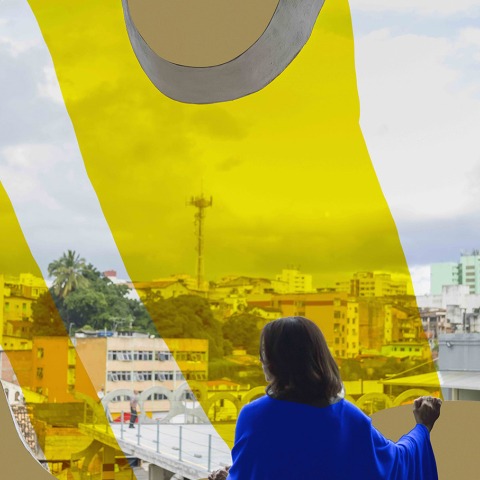Travelling further north, the work also encounters Bo Bardi’s buildings in Salvador: the Museum of Modern Art; the Coaty Restaurant and the Gregório de Mattos theatre. Starring Academy Award-nominee Fernanda Montenegro and her daughter, Cannes-laureate actor Fernanda Torres, A Marvellous Entanglement portrays Bo Bardi at different stages of her life, as the actresses interpret excerpts from the architect’s writings.
A central figure of Latin American modernist architecture, Bo Bardi devoted her working life to promoting the social and cultural potential of art, architecture and design. Exploring these themes, A Marvellous Entanglement uses the iconic staircase that she designed for the Museum of Modern Art, Bahia, as the stage upon which Julien orchestrates an original work by choreographer Zebrinha, performed by the Balé Folclórico de Bahia.
The Coaty, a modern ruin perched on the Ladeira de Misericórdia in Salvador, accommodates in turn a series of performances by Brazilian art collective Araká. In close collaboration with Julien, the collective performs in situ happenings reflecting upon the significance of Bo Bardi’s seldom-accessed masterpiece for a young contemporary audience. Another leading name of Brazilian arts, the actor, director, playwright and co-founder of São Paulo’s Teatro Oficina, José Celso Martinez Corrêa (AKA Zé Celso) worked in close collaboration with Bo Bardi and is also a key presence in the film, which includes score created by the German-Spanish composer María de Alvear.
Following the conceptual thread which Julien established in his earlier artistic investigations around portrait-making such as Ten Thousand Waves (2010), or the more recent Lessons of the Hour: Frederick Douglass (2019), Lina Bo Bardi – A Marvellous Entanglement looks at historical reparation through visual poetry, moved by the breadth and power of Bo Bardi’s work, and a profound belief that her legacy has yet to be fully acknowledged.
Isaac Julien´s multi-screen film installations and photographs incorporate different artistic disciplines to create a poetic and unique visual language. His solo exhibitions and presentations include Zeitz Museum of Contemporary Art Africa (Zeitz MOCAA), Cape Town; The Royal Ontario Museum, Toronto (2017); Fondation Louis Vuitton, Paris; Museo Universitario Arte Contemporáneo (MUAC), Mexico City (2016); Museum of Modern Art, New York; Art Institute of Chicago (2013) amongst others.
































